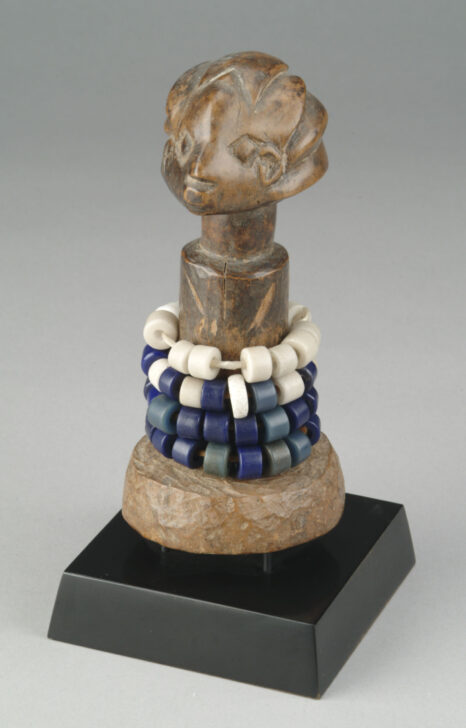Pestle
Luba

Description
Subject Matter:
This divination pestle is attributed to the Luba Shankadi from the Democratic Republic of the Congo. Divination as a way to receive oracular knowledge was widely practiced throughout central Africa, and often the diviner was second only to the chief in status. For the Luba Shankadi, the diviner, or kilumbu, served as a clairvoyant medium transversing the temporal and spiritual realms. Able to detect and communicate with unseen forces, the kilumbu aided community members by offering them diagnoses and treatments for both individual and societal crises and afflictions, such as illness, infertility, plague, and poor harvests.
During consultations with clients, the diviner would have at his disposal a number of instruments, including anthropomorphic statues representing cup (or bowl) bearers (mboko); a wooden oracle block with a carved head (katatola); a wooden board (lukasa); and, a pestle.
Used for a type of divinatory practice known as “divination par rotation,” this pestle’s figural head likely commemorates the spirit of a deceased kilumbu, whom the living diviner summons for guidance and inspiration. The colorful, beaded bracelets are offerings gifted to his spirit.
Reference:
Maurer, Evan M. and Niangi Batulukisi. Spirits Embodied: Art of the Congo, Selections from the Helmut F. Stern Collection. Minneapolis: The Minneapolis Institute of Arts, 1999.
Physical Description:
This woodcarved, cephalomorphic divination pestle is representative of the Luba Shankadi style of figural sculpture, which is characterized by an abstract and schematic form. The head features a convex face, diamond-shaped eyes carved in relief, a ridged forehead and nose, an oblong mouth, and a long, cylindrical neck. The figure’s terraced, cascading coiffure is typical of hairstyles found in the Shankadi region. Four strands of china beads, white and blue in color, have been tied around the pestle and sit atop its circular base.
Usage Rights:
If you are interested in using an image for a publication, please visit https://umma.umich.edu/request-image/ for more information and to fill out the online Image Rights and Reproductions Request Form.